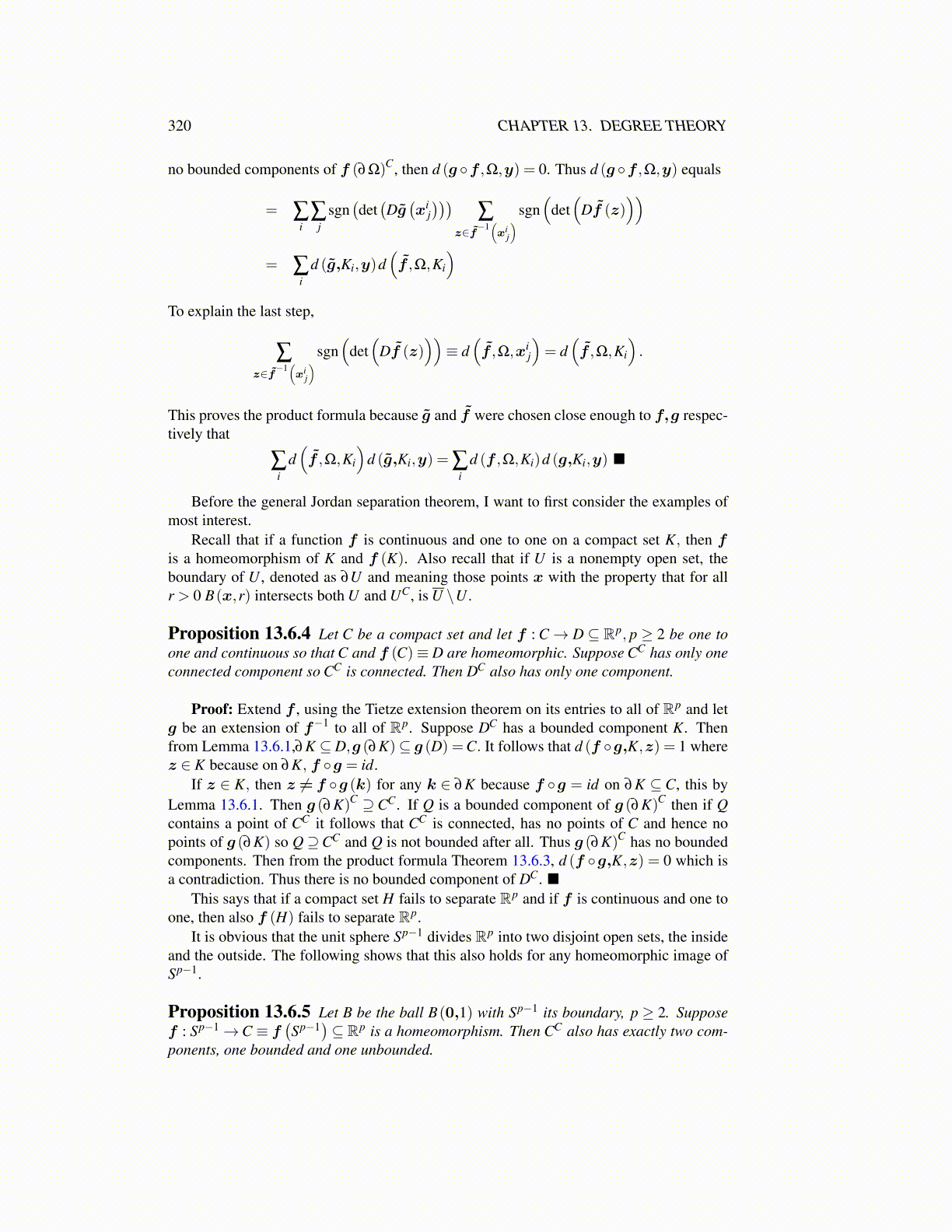
320 CHAPTER 13. DEGREE THEORY
no bounded components of f (∂Ω)C, then d (g ◦f ,Ω,y) = 0. Thus d (g ◦f ,Ω,y) equals
= ∑i
∑j
sgn(det(Dg̃(xi
j)))
∑z∈f̃−1
(xi
j
)sgn(
det(
Df̃ (z)))
= ∑i
d (g̃,Ki,y)d(f̃ ,Ω,Ki
)To explain the last step,
∑z∈f̃−1
(xi
j
)sgn(
det(
Df̃ (z)))≡ d
(f̃ ,Ω,xi
j
)= d
(f̃ ,Ω,Ki
).
This proves the product formula because g̃ and f̃ were chosen close enough to f,g respec-tively that
∑i
d(f̃ ,Ω,Ki
)d (g̃,Ki,y) = ∑
id (f ,Ω,Ki)d (g,Ki,y) ■
Before the general Jordan separation theorem, I want to first consider the examples ofmost interest.
Recall that if a function f is continuous and one to one on a compact set K, then fis a homeomorphism of K and f (K). Also recall that if U is a nonempty open set, theboundary of U , denoted as ∂U and meaning those points x with the property that for allr > 0 B(x,r) intersects both U and UC, is U \U .
Proposition 13.6.4 Let C be a compact set and let f : C→ D ⊆ Rp, p ≥ 2 be one toone and continuous so that C and f (C)≡D are homeomorphic. Suppose CC has only oneconnected component so CC is connected. Then DC also has only one component.
Proof: Extend f , using the Tietze extension theorem on its entries to all of Rp and letg be an extension of f−1 to all of Rp. Suppose DC has a bounded component K. Thenfrom Lemma 13.6.1,∂K ⊆D,g (∂K)⊆ g (D) =C. It follows that d (f ◦g,K,z) = 1 wherez ∈ K because on ∂K, f ◦g = id.
If z ∈ K, then z ̸= f ◦g (k) for any k ∈ ∂K because f ◦g = id on ∂K ⊆ C, this byLemma 13.6.1. Then g (∂K)C ⊇ CC. If Q is a bounded component of g (∂K)C then if Qcontains a point of CC it follows that CC is connected, has no points of C and hence nopoints of g (∂K) so Q⊇CC and Q is not bounded after all. Thus g (∂K)C has no boundedcomponents. Then from the product formula Theorem 13.6.3, d (f ◦g,K,z) = 0 which isa contradiction. Thus there is no bounded component of DC. ■
This says that if a compact set H fails to separate Rp and if f is continuous and one toone, then also f (H) fails to separate Rp.
It is obvious that the unit sphere Sp−1 divides Rp into two disjoint open sets, the insideand the outside. The following shows that this also holds for any homeomorphic image ofSp−1.
Proposition 13.6.5 Let B be the ball B(0,1) with Sp−1 its boundary, p ≥ 2. Supposef : Sp−1→C ≡ f
(Sp−1
)⊆ Rp is a homeomorphism. Then CC also has exactly two com-
ponents, one bounded and one unbounded.